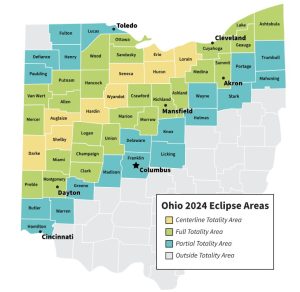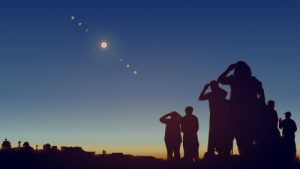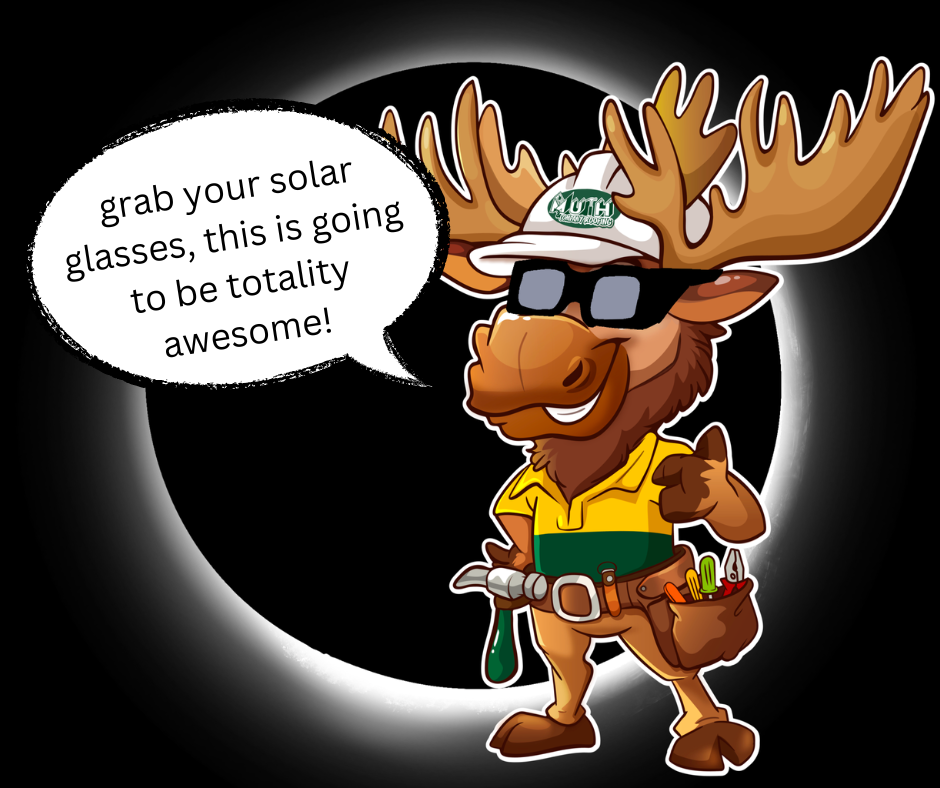The April 8 total solar eclipse will cross the U.S. from southern Texas traveling northeast through the Midwest and Ohio to Maine. It comes less than seven years after the last one on Aug. 21, 2017. The 2017 eclipse was the first one to sweep the nation since 1918.
The last total solar eclipse visible in Ohio occurred in 1806, and the next one is more than 70 years away.
So it’s understandable that this one’s a pretty big deal.
When do we see the solar eclipse?
The Ohio Emergency Management Agency website says the total eclipse will begin in Ohio at 3:08 p.m. with the final exit of the moon’s shadow at 3:19 p.m. The partial eclipse will begin at approximately 1:59 p.m. on April 8 and end at 4:29, according to NASA.

People within a 124-mile-wide band in Ohio will experience the rare total solar eclipse, which crosses the state from southwest to northeast, passing through cities such as Dayton, Springfield, Marion, Mansfield, Lima, Bowling Green, Toledo, Sandusky and Cleveland.
What you should know about solar eclipse watching
Looking directly at the Sun is unsafe without specialized eye protection for solar viewing.
Using camera lenses, binoculars, or telescopes to view any part of the bright Sun without a special-purpose solar filter securely attached to the front of the optics will cause severe eye injury instantly.
During the partial phases which occur before and after totality, it’s crucial to use safe solar viewing glasses (“eclipse glasses”) or a safe handheld solar viewer at all times. Regular sunglasses are not safe for viewing the Sun, and safe solar viewers should comply with the ISO 12312-2 international standard. Always inspect your eclipse glasses or handheld viewer for damage before use, and supervise children when they are using solar viewers.
Do not look at the Sun through a camera lens, telescope, binoculars, or any other optical device while wearing eclipse glasses or using a handheld solar viewer, as the concentrated solar rays will cause serious eye injury.

If you don’t have eclipse glasses or a handheld solar viewer, you can use an indirect viewing method, such as a pinhole projector, to view the Sun safely. Do not use eclipse glasses or handheld viewers with cameras, binoculars, or telescopes, as these require different types of solar filters.
When viewing the partial phases of the eclipse through cameras, binoculars, or telescopes equipped with proper solar filters, eclipse glasses are not necessary.
Expert advice can help your viewing
Seek expert advice from an astronomer before using a solar filter with a camera, telescope, binoculars, or any other optical device.
During a total solar eclipse, view the Sun through eclipse glasses or a handheld solar viewer during the partial eclipse phases before and after totality. Even during partial or annular eclipses, or during the partial phases of a total eclipse, the Sun will be very bright. Wear sunscreen, a hat, and protective clothing to prevent skin damage if you are watching an entire eclipse.
Interesting Facts from NASA
- After the total solar eclipse on April 8, 2024, the next one that can be seen from the contiguous United States will be on Aug. 23, 2044.
- We can’t normally see the corona – the Sun’s outer atmosphere – because the Sun’s surface below it is so much brighter. But during a total solar eclipse, the corona becomes visible, offering unique opportunities to study.
- When the Moon completely blocks the visible surface of the Sun during a total solar eclipse, viewers can remove their eclipse glasses. A total solar eclipse is the only type of solar eclipse where eclipse glasses can be momentarily removed.
- When a solar eclipse reaches totality, nocturnal wildlife sometimes wakes up, thinking that it’s nighttime, and non-nocturnal wildlife might think it’s time to head to sleep!
Above all, have fun, and enjoy this once-in-a-lifetime event happening in your backyard!


